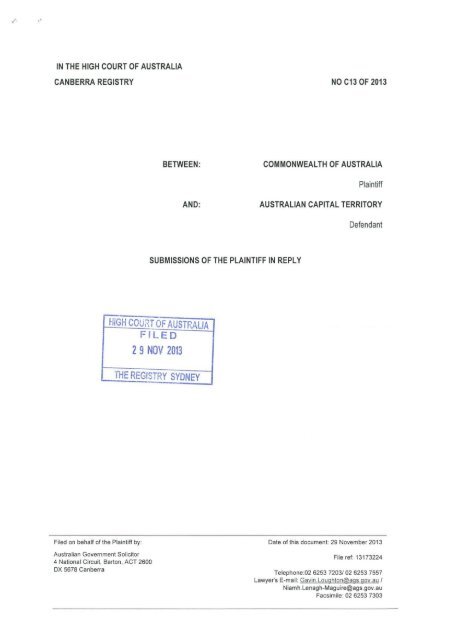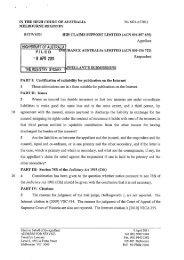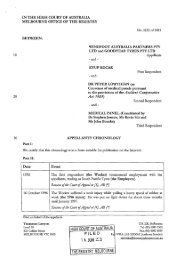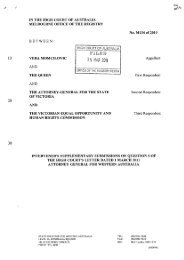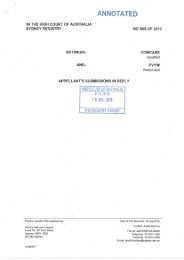Reply - High Court of Australia
Reply - High Court of Australia
Reply - High Court of Australia
Create successful ePaper yourself
Turn your PDF publications into a flip-book with our unique Google optimized e-Paper software.
IN THE HIGH COURT OF AUSTRALIA<br />
CANBERRA REGISTRY<br />
NO C13 OF 2013<br />
BETWEEN:<br />
COMMONWEALTH OF AUSTRALIA<br />
Plaintiff<br />
AND:<br />
AUSTRALIAN CAPITAL TERRITORY<br />
Defendant<br />
SUBMISSIONS OF THE PLAINTIFF IN REPLY<br />
HIGH COU:tT OF AUSTRALIA<br />
FILE D<br />
2 9 NOV 2013<br />
THE REGISTRY SYDNEY<br />
Filed on behalf <strong>of</strong> the Plaintiff by:<br />
<strong>Australia</strong>n Government Solicitor<br />
4 National Circuit, Barton, ACT 2600<br />
OX 5678 Canberra<br />
Date <strong>of</strong> this document: 29 November 2013<br />
File ref: 13173224<br />
Telephone:02 6253 7203/ 02 6253 7557<br />
Lawyer's E-mail: Gavin.Loughton@ags.gov.au I<br />
Niamh.Lenagh-Maguire@ags.gov.au<br />
Facsimile: 02 6253 7303
'•<br />
PART I<br />
FORM OF SUBMISSIONS<br />
1. These submissions are in a form that is suitable for publication on the internet.<br />
PART II<br />
ARGUMENT<br />
2. These submissions use the same abbreviations as in the Commonwealth's submissions in chief<br />
(CS). The parties differ on two matters: First, do the Marriage Act and the FLA exhaustively set out<br />
a uniform set <strong>of</strong> rules for <strong>Australia</strong> on the essential and formal characteristics <strong>of</strong> marriage, the<br />
bringing to an end <strong>of</strong> marriage and the resolution <strong>of</strong> matrimonial causes; or do such Acts deal only<br />
with one form <strong>of</strong> marriage, 'traditional marriage', and leave it open to the States and Territories to<br />
identify and make lawful as many other forms <strong>of</strong> marriage- varying the integers <strong>of</strong> 'traditional<br />
1 o marriage'- as appeal to them from time to time? Has the boundary in law between 'married' and<br />
'unmarried' been left by the Commonwealth laws infinitely moveable, in the discretion <strong>of</strong> the States<br />
and Territories? Secondly, if the ACT Marriage Act, by purporting to create a parallel status <strong>of</strong><br />
'marriage', would be inconsistent with the Marriage Act and the FLA under s 109 <strong>of</strong> the<br />
Constitution, does s 28 <strong>of</strong> the ACT Self-Government Act produce a different result?<br />
3. Before replying to the submissions <strong>of</strong> the Defendant (ACT) and the proposed intervener (AME)<br />
regarding those matters, it is convenient to address the constitutional issue regarding the reach <strong>of</strong><br />
s 51(xxi). In that regard, there first arises a question as to which constitutional question it is<br />
necessary to decide. The Commonwealth submits that, even on a narrow view <strong>of</strong> the power, a<br />
Commonwealth law could validly state that certain defined unions and no others are to bear the<br />
20 status <strong>of</strong> marriage.' Only if that argument were rejected would it be necessary for the <strong>Court</strong> to<br />
determine the larger constitutional question.<br />
A. Reach <strong>of</strong> the Marriage Act and FLA<br />
4. Genera/ construction issues There are three aspects <strong>of</strong> the overall approach <strong>of</strong> the ACT and<br />
AME to construction that should be rejected. First, the persistent attempt to find the narrowest<br />
possible basis to read the Commonwealth law, being a scheme which, as is apparent from the text,<br />
context and statutory object, was enacted on the basis that marriage is a genus crying out for<br />
uniform regulation in relation to the attaining <strong>of</strong> the status. Instead <strong>of</strong> following the logical<br />
implications <strong>of</strong> the text and apparent statutory purpose, it is said that the regulation <strong>of</strong> that status<br />
(and its loss and other consequent causes under the Matrimonial Causes Act or the FLA) should<br />
30 be understood as dealing only with a particular form <strong>of</strong> status at the time <strong>of</strong> those enactments. That<br />
seemingly invites this <strong>Court</strong> to apply some form <strong>of</strong> contemporanea expositio principle <strong>of</strong><br />
construction. That has long been abandoned in <strong>Australia</strong> as a generally applicable approach' and<br />
is inapposite in the context <strong>of</strong> the Marriage Act.' Marriage is a dynamic and developing institution,<br />
a matter that was well understood and anticipated at the time <strong>of</strong> the enactment <strong>of</strong> the Marriage<br />
Acl. 4 And as such, it is inherently unlikely that Parliament intended to provide for what AME<br />
accepts was a single Federal code by reference solely to the metes and bounds <strong>of</strong> the law or<br />
institution <strong>of</strong> marriage frozen in time as at 1961, such that its initial uniformity could be whittled<br />
'AME's submission atl17]to the contrary is incorrect. All that is required is a sufficient connection with the subject matter <strong>of</strong> 'marriage'. The<br />
marriage power allows Parliament to prescribe what unions are to be regarded as 'marriage': Attorney-Genera/ <strong>of</strong> NSW v Brewery<br />
Employees Union <strong>of</strong> NSW (1908) 6 CLR 469 at610. If the power is to be efficacious, that necessarily involves saying what marriage is not.<br />
By analogy, the banking power authorises a Commonwealth law that prevents a body that is not licensed as a bank, and could nol<br />
constitutionally be a bank, from using 'bank' or 'banking' in carrying on a financial service (Banking Act 1959 (Cth), s 66). To take a closer<br />
example, the marriage power plainly extends to the prohibition <strong>of</strong> polygamous marriage, the regulation <strong>of</strong> its effects and the creation <strong>of</strong><br />
associated <strong>of</strong>fences, whether or not it would be within the power <strong>of</strong> the Commonwealth to make polygamy lawful throughout <strong>Australia</strong>:<br />
Attorney-Genera/ (Vic) v The Commonwealth (1961) 107 CLR 529, particularly at 577 per Windeyer J. The same is true <strong>of</strong> same sex<br />
marriages.<br />
2 See eg Stingel v Clarke (2006) 226 CLR 442 at458-459127] per Gleeson CJ, Callinan, Heydon and Grennan JJ and The Council <strong>of</strong>the<br />
Shire <strong>of</strong> Lake Macquarie v Aberdare County Council (1970) 123 CLR 327 at331 per Barwick CJ (Menzies J agreeing at332].<br />
3<br />
As was held in Attorney-General (Cth) v Kevin (2003) 172 FLR 300 (upon which the ACT relies at ]52]) at362-330 1365]-]371].<br />
4 Attorney-General (Vic) v The Commonwealth (1961]107 CLR 529 at577, 579-580 per Windeyer J.<br />
Submissions <strong>of</strong> the Plaintiff in reply Page 1
10<br />
5.<br />
away as the law was further developed by the States and Territories.<br />
The second key error, particularly in the submissions <strong>of</strong> the ACT, is to dismiss the reason for the<br />
insertion <strong>of</strong> the marriage power in the Constitution and the extrinsic materials regarding the<br />
subsequent exercise <strong>of</strong> that power as irrelevant to the task <strong>of</strong> construction. Viewed correctly, the<br />
extrinsic materials and the historical context usefully illuminate the objective statutory purpose <strong>of</strong><br />
the Marriage Act, which was to exhaustively codify for <strong>Australia</strong> the law <strong>of</strong> marriage both at the<br />
time <strong>of</strong> that enactment and prospectively: see CS [11]-[19]. The very authorities upon which the<br />
ACT relies for the contrary proposition make plain that such material may be used for that task.s<br />
Identification <strong>of</strong> such a purpose is not logically congruent with that <strong>of</strong> 'subjective purpose or<br />
intention' (contra ACT [42]), even if the two coincide.• Those matters, and the broader historical<br />
context, point to the mischief to be addressed by the Marriage Act 7 and, indeed, the reason for the<br />
insertion <strong>of</strong> the power ins 51 in the first place. It is erroneous to put all <strong>of</strong> that to one side and<br />
pretend that the process <strong>of</strong> statutory construction may be conducted with the Act in one hand and<br />
a dictionary in the other.• And none <strong>of</strong> that involves 'inconsistency <strong>of</strong> political opinion' (contra ACT<br />
[43]). As was explained in Momcilovic v The Queen,' the question is rather whether, applying<br />
orthodox rules <strong>of</strong> construction, a federal law is a complete statement <strong>of</strong> the law governing a<br />
particular matter so as to give rise to what Gum mow J termed an 'implicit negative proposition' that<br />
nothing other than what the Federal law provides on that subject matter is to be the subject <strong>of</strong><br />
State or Territory legislation.<br />
20 6. The third key error, made by the ACT but not AME, is to construe Commonwealth enactments as<br />
objectively intended to have a narrower operation in the Territory than across the Commonwealth<br />
as a whole.<br />
30<br />
40<br />
7.<br />
8.<br />
Definition ins 5(1) The role <strong>of</strong> the definition <strong>of</strong> 'marriage' ins 5(1) <strong>of</strong> the Marriage Act is to confirm<br />
what was implicit in any event, namely that the core essential requirements for the validity <strong>of</strong><br />
marriage under the law <strong>of</strong> <strong>Australia</strong> are the four matters there specified. The specification <strong>of</strong> each<br />
<strong>of</strong> those four essential requirements, in this particular statutory context, necessarily excludes other<br />
variants from that status. And that is so regardless <strong>of</strong> whether the Commonwealth enactment<br />
imposes 'express prohibitions' or rules requiring that people abstain from entry into those variants.<br />
The Marriage Act prescribes the rules regulating marriage, and they are uniform and exhaustive for<br />
those who wish to acquire that status in the <strong>Australia</strong>n community. The position was aptly<br />
summarised by Pr<strong>of</strong>essor Hart, who observed:<br />
... some rules are mandatory in the sense that they require people to behave in certain ways e.g. abstain<br />
from violence or pay taxes, whether they wish to or not; other rules such as those prescribing the<br />
procedures, formalities and conditions for the making <strong>of</strong> marriages, wills and contracts indicate what<br />
people should do to give effect to the wishes they have. 10<br />
The ACT and AME fail to grapple with the effect <strong>of</strong> the definition ins 5(1); nor do they explain what<br />
alternative role it might sensibly be given in the context <strong>of</strong> the statute. Rather, they seek to<br />
advance the startling proposition that it has confirmed that the Marriage Act does nothing more<br />
than regulate unions falling within that 'expressly self-limited' definition: a union between a man<br />
and woman to the exclusion <strong>of</strong> others, voluntarily entered into for life." Again, the contest between<br />
'See, in addition to Laceyv Affomey-General (OLD) (2011) 242 CLR 573 at [44] and Certain Lloyd's Underwrilers v Cross (2012) 87 ALJR<br />
131 at 138 [25] per French CJ and Hayne J, Akiba v Commonwea/Jh (2013) 87 ALJR 916 at 925 [31] per French CJ and Grennan J and Lee<br />
v New Soulh Wales Crime Commission (2013) 302 ALR 363 at 386 [45] per French CJ. See also the discussion <strong>of</strong> the 'modern approach to<br />
statutory interpretation' in GIG Insurance Limited v Bankstown Football Club Limited (1997) 187 CLR 384 at 408.<br />
'Lee v New Soulh Wales Crime Commission (2013) 302 ALR 363 at 386 [45] per French CJ.<br />
7 See eg Network Ten Ply Limited v TCN Channel Nine (2004) 218 CLR 273 at [11[-[12).<br />
8 APLA Ltd v Legal Services Commissioner for New South Wales [2005) 224 CLR 322 at 462 [423] per Hayne J.<br />
'(2011) 245 CLR 1 at 111 [244].<br />
10 The Concept <strong>of</strong> Law (Oxford University Press, 1" ed, 1961) p 9.<br />
11<br />
AME [55], see also [52], ACT [29], [32] and [55].<br />
Submissions <strong>of</strong> the Plaintiff in reply Page 2
these competing views is to be resolved by the application <strong>of</strong> orthodox principles <strong>of</strong> statutory<br />
interpretation. The Commonwealth's submissions are supported by, and the alternative view<br />
denied by, the text <strong>of</strong> the definition (CS [35]), the purpose <strong>of</strong> the provision (CS [34]) within the<br />
broader purpose <strong>of</strong> the Marriage Act (CS [16]-[19],[23])), and the context within which it operates,<br />
especially having regard to s 6 (CS [22]), s 46(1) (CS [20.1 ]), and the provisions generally <strong>of</strong><br />
Division 2 <strong>of</strong> Part IV (see below [11]-[12]).<br />
9. Further telling against the construction proposed by the ACT and AME, s BBEA (which was<br />
inserted with the definition ins 5(1)) would, on their proposed construction, involve some form <strong>of</strong><br />
anomalous discrimination against persons who married in another country: see CS [36]. The fact<br />
1 o that s BBEA was inserted by the very same amending Act which added the definition to s 5(1)<br />
confirms the opposite is true: if a same sex marriage took place outside <strong>Australia</strong>, it would not be<br />
recognised; and the addition <strong>of</strong> s 5(1) put beyond any doubt that such a marriage could not take<br />
place under the uniform law <strong>of</strong> marriage in <strong>Australia</strong>." The definition obviated the need for a further<br />
express provision like s BBEA to apply to unions solemnised in <strong>Australia</strong>. Moreover, if the ACT and<br />
AME are correct, the use <strong>of</strong> any one <strong>of</strong> the ingredients <strong>of</strong> the definition in s 5(1) could be used to<br />
develop a statutory cocktail at the State or Territory level with absurd results: eg same-sex,<br />
temporary, polygamous, involuntary, underage or incestuous marriages.<br />
10. Section 238 <strong>of</strong> the Marriage Act The ACT and AME also radically overstate the significance <strong>of</strong><br />
the grounds for void marriages under s 238(1) <strong>of</strong> the Marriage Act and the fact that the Marriage<br />
20 Act does not specifically designate same sex relationships as 'prohibited relationships' for the<br />
purposes <strong>of</strong> s 238(2). 13 First, as to prohibited relationships, that submission overlooks the subject<br />
matter <strong>of</strong> s 238(2), which concerns the prohibited degrees <strong>of</strong> consanguinity and (to the extent<br />
adoptive children do not fall within that notion) affinity. That is, it involves a second order essential<br />
requirement, regarding whether there exists a matter <strong>of</strong> blood or relationship that the law considers<br />
too close. One would hardly expect the question <strong>of</strong> whether same sex parties could marry would<br />
be dealt with in such a provision.<br />
11. Secondly, it is well established that there are in fact three possibilities in respect <strong>of</strong> any ceremony<br />
<strong>of</strong> marriage: it may be valid; it may be void by reason <strong>of</strong> s 238(1) or it may be no marriage at all."<br />
Obiter observations <strong>of</strong> the Family <strong>Court</strong> correctly include same sex marriage in the last mentioned<br />
30 category. 15 So too would be temporary marriages. The search for an 'express prohibition' as<br />
regards such unions is therefore futile. They are simply excluded from the status <strong>of</strong> marriage by<br />
the implicit negative proposition that appears from the terms, nature and subject matter <strong>of</strong> the<br />
Marriage Act.<br />
12. Thirdly, the suggestion that an approach 'akin to the principle <strong>of</strong> legality' is to be applied is similarly<br />
misplaced (AME [68]). Little assistance is derived from seeking to invoke a general presumption<br />
against the very thing the Act seeks to achieve.'•<br />
13. Division 2 <strong>of</strong> Part IV A third specific issue separating the parties concerns Division 2 <strong>of</strong> Part IV.<br />
The question is whether it is confined to prescribing the procedures, formalities and conditions for<br />
the valid formation <strong>of</strong> some (but by no means all) kinds <strong>of</strong> marriages, ie those which happen to<br />
40 answer the description ins 5(1) <strong>of</strong> the Act (as submitted by the ACT and AME); or whether it rather<br />
provides a code which applies to any union which seeks to confer upon the parties the status <strong>of</strong><br />
12 The decision <strong>of</strong> the Full Family <strong>Court</strong> the year before in Afforney-General (Cth) v Kevin (2003) 172 FLR 300 might have given focus to the<br />
question (see at 3251126]-[127] and [132], 236-71137)-[138] and 362-31366]-[371]), although it was not an issue in the case (see at 17 [67)).<br />
13 AME at [56].<br />
14 Sees 113 <strong>of</strong> the FLA and In the Marriage <strong>of</strong>VK and Kapadia [1991) 14 Fam LR 883 at 886-887; Dina/ and Tohim (No 2) [2009] Fam CA<br />
540 at [39]; Carroll and Sinclair 12011] FamCA 651 at 122]-[26]. See also, in the United Kingdom, R v Bham 11965]1 QB 159.<br />
15 /n the Marriage <strong>of</strong> VK and Kapadia (1991) 14 Fam LR 883 at 886: 'If the parties are not <strong>of</strong> the opposite sex, there is no marriage.'<br />
16 Lee v NSW Crime Commission (2013) 302 ALR 363 at 4521314] per Gageler and Keane JJ. In any event, the materials noted at CS [34]<br />
show that the Commonwealth Parliament clearly confronted what it was doing and that it accepted the political cost.<br />
Submissions <strong>of</strong> the Plaintiff in reply Page 3
'married persons' at general law; i.e. persons who are properly described as 'married' and to whom<br />
the law annexes peculiar legal rights, duties, capacities and incapacities. The correct view is the<br />
latter: the Division sets out the formal requirements designed to carry into effect the singular notion<br />
<strong>of</strong> marriage for the whole law <strong>of</strong> <strong>Australia</strong>, which has been identified through the essential<br />
requirements ins 5(1). The text <strong>of</strong> ss 40(1) and 48(1) points to the fact that the ACT's and AME's<br />
submissions regarding s 5(1) involve a red herring: 21! marriages solemnised in <strong>Australia</strong> are to be<br />
solemnised in accordance with that Division" and not otherwise, because the only marriages that<br />
may be solemnised in <strong>Australia</strong> are the marriages which are permissible under the Act (s 5(1)<br />
marriages)." Other purported unions are simply not marriages at all (including same sex and<br />
10 temporary marriages) or void (bigamous and involuntary marriages).<br />
14. The tie between the essential requirements ins 5(1) and the uniform formal requirements for<br />
solemnisation <strong>of</strong> marriages in <strong>Australia</strong> is also evident. This can be seen in the notion <strong>of</strong> a common<br />
set <strong>of</strong> authorised celebrants for marriage in <strong>Australia</strong> (s 41 ); a common set <strong>of</strong> notification<br />
provisions which are designed to enable the parties to disclose and the authorised celebrants to<br />
verify whether the essential requirements are satisfied (s 42); 19 a common standard for public<br />
witnessing (s 44); a common form <strong>of</strong> ceremony (with some flexibility to allow for religious variations<br />
- s 45); and a common statement at ceremonies not solemnised by a minister <strong>of</strong> a religion <strong>of</strong> a<br />
recognised denomination which affirms that marriage, for the law <strong>of</strong> <strong>Australia</strong>, has the<br />
requirements <strong>of</strong> the definition ins 5(1) (s 46(1)). The importance <strong>of</strong> those various formal<br />
20 requirements is carried through by the recognition in s 48 that the contravention <strong>of</strong> at least some<br />
will result in the marriage being void.<br />
B. ACT Marriage Act is inconsistent with the Marriage Act and the FLA<br />
15. Test <strong>of</strong> inconsistency: The central error in the ACT submissions regarding this issue is to seek to<br />
draw an analogy between s 28 <strong>of</strong> the ACT Self-Government Act and a Commonwealth provision<br />
stating that a Commonwealth Act is not intended to exclude State laws that are capable <strong>of</strong><br />
operating concurrently (contra ACT [12]). When a 'concurrent operation provision' is inserted into<br />
a Commonwealth Act it may assist in arriving at a conclusion that that Act is not intended to be an<br />
exhaustive statement <strong>of</strong> the law on a particular topic for <strong>Australia</strong> and, in turn, may inform the<br />
interpretation <strong>of</strong> other provisions <strong>of</strong> the same Act. The purpose <strong>of</strong> s 28 in an Act conferring powers<br />
30 on a subordinate legislature is to place a limit on that power so that, as between two separate laws<br />
which conflict, it is the law <strong>of</strong> the primary legislature which prevails. While concurrency is specified<br />
as the test for the identification <strong>of</strong> inconsistency, concurrency is not ascertained by modifying the<br />
true operation <strong>of</strong> the laws <strong>of</strong> the primary legislature. It may, depending upon the circumstances,<br />
inform the interpretation <strong>of</strong> ACT taws, by permitting them to be 'read down' to avoid an<br />
inconsistency.'"<br />
16. The correctness <strong>of</strong> that view is confirmed by the context. Under s 34(4) <strong>of</strong> the ACT Self<br />
Government Act, subject to certain exceptions, the previous ACT ordinances were converted into<br />
'enactments' on the basis that Commonwealth Acts continued to operate fully in the Territory.<br />
Equally it would be a bizarre result if s 28 meant that (as at that date) uniform Commonwealth laws<br />
40 intended to be exhaustive statements <strong>of</strong> law on particular subject matters were rolled back to<br />
enable the ACT to pass enactments so as to alter, impair or detract from that uniformity.<br />
17. In examining any argument concerning possible concurrency, it remains critical to properly<br />
17<br />
Or Division 3 <strong>of</strong> Part IV.<br />
18<br />
See also the long lille: An Act relating to marriage.<br />
"See also the Marriage Regulations 1963 (Cth) which prescribe the form <strong>of</strong> notice (by Form 13) to be given pursuant to s 42 and the form<br />
<strong>of</strong> declaration by a party to a proposed marriage (by Form 14).<br />
20 See, by way <strong>of</strong> analogy, Webster v Macintosh (1980) 32 ALR 603 at 605. Writing extra-judicially, Justice Leeming has suggested that a<br />
further analogy may be seen ins 73 <strong>of</strong> the Aboriginal Land Rights (Norlhem Territory) Act 1976 (Cth) considered in Gumana v Norlhem<br />
Territory (2007) 158 FCR 349 at [103[ (see M Leeming, Resolving Conflicts <strong>of</strong> Laws (Federation Press, 2011) pp 240-241).<br />
Submissions <strong>of</strong> the Plaintiff in reply<br />
Page4
construe the law <strong>of</strong> the primary legislature. Where, as here, that law is intended to provide an<br />
exhaustive statement <strong>of</strong> law on the topic which operates uniformly across <strong>Australia</strong>, an ACT law<br />
will necessarily be incapable <strong>of</strong> concurrent operation when it purports to introduce variation in the<br />
law for cases concerned with the ACT when such variation would not be permitted in any <strong>of</strong> the<br />
States. And even if it were otherwise, the effect <strong>of</strong> the 2004 amendments was to impliedly repeal<br />
s 28 to that extent.<br />
18. A further error in the ACT's argument is that it would mean that the Commonwealth can only<br />
legislate to the exclusion <strong>of</strong> ACT laws by expressly excluding those laws, or (previously) by<br />
exercising the power to disallow ACT laws (ACT [14], [16]). But there is no requirement that an<br />
10 intention <strong>of</strong> a Commonwealth law to operate to the exclusion <strong>of</strong> State and Territory laws be stated<br />
expressly; this intention can be discerned under the usual rules <strong>of</strong> interpretation .2 1 And removing<br />
inconsistency between Commonwealth and ACT laws is not just a matter between polities, but also<br />
protects citizens by ensuring they are not subject to inconsistent commands. 22 It cannot be<br />
dependent on the exercise <strong>of</strong> a disallowance power.<br />
19. Uncertainty and complexity: The assertion that the ACT Marriage Act will not reintroduce the<br />
'scandal' deprecated in Fremlin v Fremlin23 does not withstand analysis. A relationship created by<br />
an ACT law cannot operate <strong>of</strong> its own force in other law areas <strong>of</strong> <strong>Australia</strong> (despite s 6 <strong>of</strong> the ACT<br />
Marriage Act) -its recognition outside the ACT will therefore depend on the operation <strong>of</strong> other<br />
rules (particularly rules <strong>of</strong> private international law). This will inevitably lead to uncertainty and<br />
20 complexity. For example, if a couple are married in the ACT, but a dispute later arises in a State,<br />
say NSW, issues will arise with whether their marriage is to be recognised in that State, both<br />
generally and for the purpose <strong>of</strong> State legislation that uses 'marriage' as an operative status .24<br />
Also, the notion that persons could have the status <strong>of</strong> 'married' under ACT law but 'de facto' under<br />
Commonwealth law is the very consequence that the Commonwealth Acts were enacted to avoid<br />
(contra ACT [60]). Private international law rules whether based upon domicile or otherwise will<br />
need to be revivified. In so doing, the ACT Marriage Act shatters the uniformity intended by<br />
Commonwealth Acts and purports to subordinate their norms to its norm.<br />
Dated: 29 November 2013<br />
t::!!;.~;~<br />
Solicitor-General <strong>of</strong> the Commonwealth<br />
Telephone: 02 6141 4145<br />
Facsimile: 02 6141 4149<br />
Email: justin.gleeson@ag.gov.au<br />
Michael Kearney SC<br />
Telephone: 02 9264 8444<br />
Facsimile: 02 9264 8944<br />
E: kearneysc@waratahchambers.com.au<br />
30<br />
Craig Lenehan<br />
Telephone: 02 8257 2530<br />
Facsimile: 02 9221 8387<br />
Email: craig.lenehan@stjames.net.au<br />
Graeme Hill<br />
Telephone: 03 9225 6701<br />
Facsimile: 03 9640 3108<br />
Email: graeme.hill@vicbar.com.au<br />
Counsel for the Commonwealth<br />
21 See eg O'Sullivan v Noarlunga Meat Ltd (1954) 92 CLR 565 at 591 (Fullagar J, with Dixon CJ and Kitto J agreeing): the 'extremely<br />
elaborate and detailed set <strong>of</strong> requirements' contained in the Commonwealth regulations excluded State regulations <strong>of</strong> that subject.<br />
22 See Dickson v The Queen (201 0) 241 CLR 491 at 503-504 [19] (the <strong>Court</strong>).<br />
23 (1913) 16 CLR 212; CS [15]. Contra ACT [41]. [53].<br />
24 For example, Succession Act 2006 (NSW), s 12 (a will is revoked by the 'marriage' <strong>of</strong> the testator); Property (Relationships) Act 1984<br />
(NSW), s 4(1)(b) (definition <strong>of</strong> 'de facto relationship' excludes people who are married) ; Married Persons (Equality <strong>of</strong> Status) Act 1996<br />
(NSW), s 13 (a 'spouse' can apply to recover his or her money that was invested without his or her consent by the other spouse).<br />
Submissions <strong>of</strong> the Plaintiff in reply Page 5
ERRATA<br />
CORRECTIONS TO COMMONWEALTH'S SUBMISSIONS DATED 13 NOVEMBER 2013<br />
Page 3, footnote 7:<br />
For "h thaf' read "Thaf'<br />
Page 10, para 20.2:<br />
For "18 for females and 16 for males" read "16 for<br />
females and 18 for males"<br />
Page 10, para 20.2<br />
For "a position that previously applied only in South<br />
<strong>Australia</strong>" read "a position that previously applied<br />
only in South <strong>Australia</strong>, Tasmania and Western<br />
<strong>Australia</strong>"<br />
Page 16, para 42 (last line):<br />
For "under Part <strong>of</strong> the Domestic Relationships<br />
Act 1984" read "under Part 3 <strong>of</strong> the Domestic<br />
Relationships Act 1994"<br />
A2633794 - v1.0


